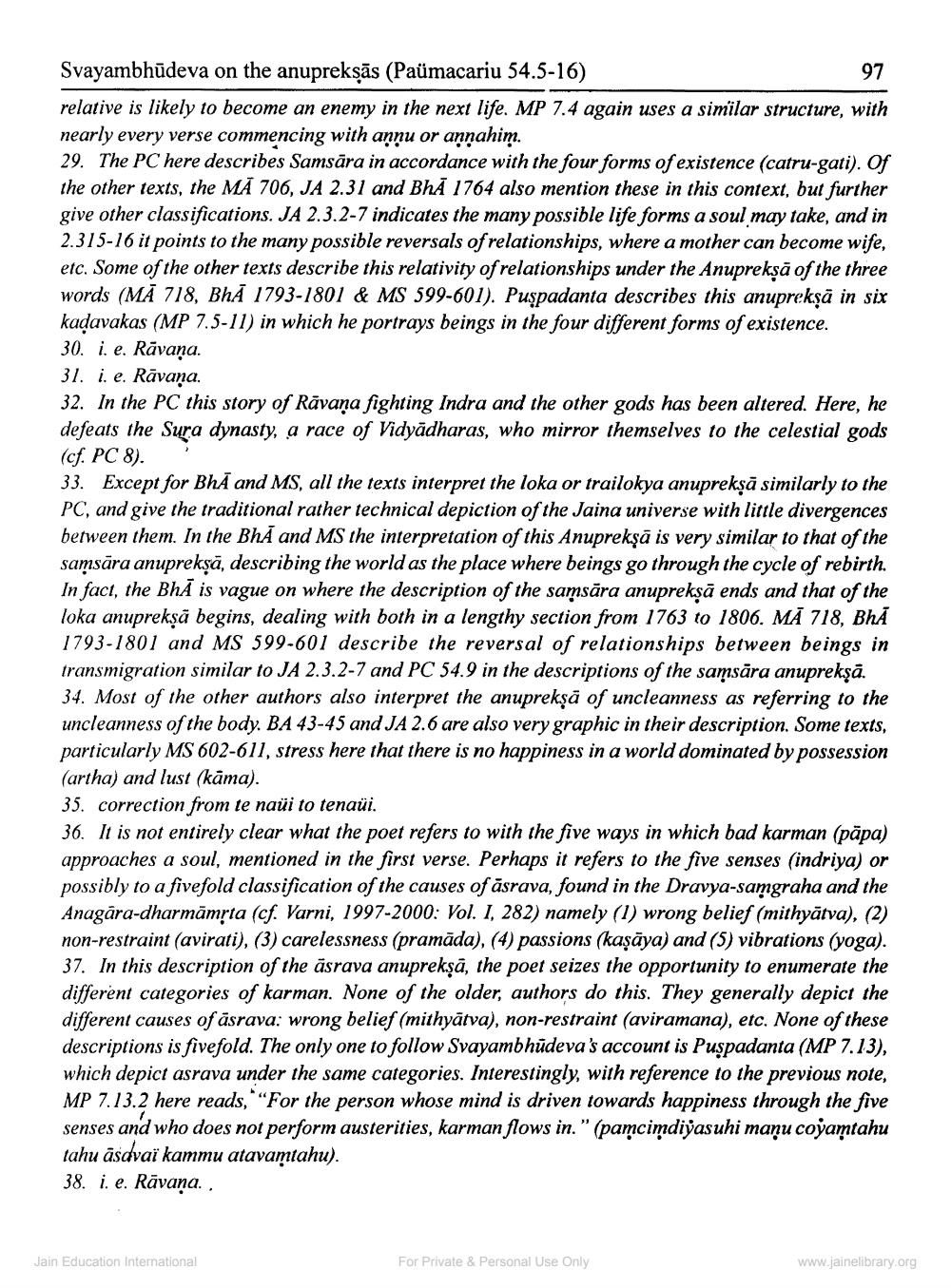________________
97
Svayambhūdeva on the anupreksās (Paümacariu 54.5-16) relative is likely to become an enemy in the next life. MP 7.4 again uses a similar structure, with nearly every verse commencing with annu or annahim. 29. The PC here describes Samsāra in accordance with the four forms of existence (catru-gati). Of the other texts, the MĂ 706, JA 2.31 and BhĀ 1764 also mention these in this context, but further give other classifications. JA 2.3.2-7 indicates the many possible life forms a soul may take, and in 2.315-16 it points to the many possible reversals of relationships, where a mother can become wife, etc. Some of the other texts describe this relativity of relationships under the Anupreksā of the three words (MĀ 718, BhĀ 1793-1801 & MS 599-601). Puspadanta describes this anupreksă in six kadavakas (MP 7.5-11) in which he portrays beings in the four different forms of existence. 30. i. e. Rāvana. 31. i. e. Rāvana. 32. In the PC this story of Rāvana fighting Indra and the other gods has been altered. Here, he defeats the Sura dynasty, a race of Vidyādharas, who mirror themselves to the celestial gods (cf. PC 8). 33. Except for BhĀ and MS, all the texts interpret the loka or trailokya anuprekşā similarly to the PC, and give the traditional rather technical depiction of the Jaina universe with little divergences between them. In the Bh) and MS the interpretation of this Anuprekşā is very similar to that of the samsāra anuprekṣā, describing the world as the place where beings go through the cycle of rebirth. In fact, the Bhis vague on where the description of the samsāra anuprekķā ends and that of the loka anupreksā begins, dealing with both in a lengthy section from 1763 to 1806. MĀ 718, Bh. 1793-1801 and MS 599-601 describe the reversal of relationships between beings in transmigration similar to JA 2.3.2-7 and PC 54.9 in the descriptions of the samsāra anuprekşā. 34. Most of the other authors also interpret the anuprekṣā of uncleanness as referring to the uncleanness of the body. BA 43-45 and JA 2.6 are also very graphic in their description. Some texts, particularly MS 602-611, stress here that there is no happiness in a world dominated by possession (artha) and lust (kāma). 35. correction from te naüi to tenaüi. 36. It is not entirely clear what the poet refers to with the five ways in which bad karman (pāpa) approaches a soul, mentioned in the first verse. Perhaps it refers to the five senses (indriya) or possibly to a fivefold classification of the causes of asrava, found in the Dravya-samgraha and the Anagāra-dharmāmsta (cf. Varni, 1997-2000: Vol. I, 282) namely (1) wrong belief (mithyātva), (2) non-restraint (avirati), (3) carelessness (pramāda), (4) passions (kaşāya) and (5) vibrations (yoga). 37. In this description of the āsrava anuprekşā, the poet seizes the opportunity to enumerate the different categories of karman. None of the older, authors do this. They generally depict the different causes of asrava; wrong belief (mithyātva), non-restraint (aviramana), etc. None of these descriptions is fivefold. The only one to follow Svayambhūdeva's account is Puspadanta (MP 7.13), which depict asrava under the same categories. Interestingly, with reference to the previous note, MP 7.13.2 here reads, “For the person whose mind is driven towards happiness thro senses and who does not perform austerities, karman flows in." (pamcimdiyasuhi manu coyamtahu tahu asdvaï kammu atavamtahu). 38. i. e. Rāvana.
Jain Education International
For Private & Personal Use Only
www.jainelibrary.org




